Is Air Travel Getting Worse?
More delays, fewer accidents, and lower prices
Over the past couple of years, bad personal experiences with delays, testimonies from friends, and news or reactions to air travel incidents seem to have become much more common.
It’s difficult to tell if these extra anecdotes reflect a change in the true rate of airline accidents and delays or if they instead result from fluctuations in the human social layer where confirmation bias, saliency, and mimesis can draw our concern far out of proportion.
Thus, I turn to the primary source data. Here are the high-level conclusions:
Long delays have become much more common. A 3-hour delay is 4x more likely in 2024 than in 1990, but airlines have masked this increase by padding scheduled flight times.
Air travel remains safe; accidents are still on a slow downward trend
Airfare has become much cheaper over the past 10 years
Read on to see the primary source data from which these conclusions are drawn and for my best guesses as to what is causing these trends.
Delays
The data source here is the Bureau of Transportation Statistics’ Airline On-Time Performance Data. This data covers every non-stop domestic flight in the US since 1987 and tracks scheduled and actual departure/arrival times, canceled and diverted flights, taxi-out and taxi-in times, causes of delay and cancellation, air time, and non-stop distance.
All of this data is about 100gb uncompressed, so to work with the data I first aggregate up all of the numbers to the Year-Month-Route level.
One way to measure delays is too look at the difference between the scheduled flight time and the actually realized flight time. If we look at the distribution of average delay across all routes in 1990, we get a graph that looks like this:
The average flight on most routes arrives right around their scheduled time, some are early, some are late, with a slight skew towards delays rather than early arrivals. So if delays are getting more common and/or longer then we should see this distribution shift to the right. Here’s what it looks like in 2024:
I claimed at the top that delays are getting more common, but this shows the exact opposite! Somehow, on ~85% of routes in 2024, the average flight was early! Before celebrating the well-oiled machinery of commercial aviation, we should practice some suspicion. Why, after all, wouldn’t the scheduled flight times update to match the actual most likely flight time? And why does it nonetheless seem like every other flight I’m on these days is late?
Here’s another perspective on this data. Instead of looking at the difference between actual and scheduled times, we can look at the total scheduled and realized flight times over the years.
Note that in this graph, I am holding the routes constant to the set of routes that show up in every year in the data and I am holding the weights on the weighted average constant to the number of flights on each route in 2024, so that the trends here reflect changes within the same routes rather than composition shifts across routes.
Now we have some explanation for the pattern we saw above. Within the same routes, flights are now about 10 minutes longer than they were in 1987, partly reflecting more frequent delays pulling up average flight times and partly due to slower cruising speeds for fuel saving.
Starting around 2008, Scheduled flight times began increasing even faster than actual ones, and are now 20 minutes longer than their 1987 pairs along the same routes. This divergence makes it look like far more flights are early in 2024 when in reality almost all flights are taking longer.
Similarly, if take all the routes in the 2024 graph and compare the actual flight time to the scheduled flight time on that same route in 1990, we see that most flights in 2024 are late by 1990 standards.
The extra 10 minutes across all of these routes probably costs travelers something like $6 billion a year, but it doesn’t prove my claim at the start that long delays are becoming more likely. For that, we need to return to the difference between scheduled and actual times, despite the bias of rising scheduled flight times.
Along each route, we count up the total number of delayed flights, defined with different thresholds: 15, 60, 90, or 180+ minutes late arrival. Then we take an average of the share of flights delayed across each route, weighted by 2024 volumes again so we don’t capture any effects of changing composition of routes.
Consistent with the picture above of most flights being “early”, the prevalence of 15+ minute delays has decreased somewhat since the 90s. It looks like the share of flights crossing the other delay thresholds may have increased but the base rates are so low that it’s hard to see, so in the next graph I scale all the 1990 values to 100 to see how the rates have changed over time.
Again we see that the rate of 15+ minute delays has been stable, but it’s much clearer here that catastrophic delays have become far more common. It’s 4.5 times more likely to have your flight delayed by more than 3 hours today than it was in 1990. 1-1.5hr delays are both around twice as common as well.
Just to emphasize that this isn’t about changing composition to low-volume, more delay prone routes, here is how the 3+ hour delay percentages have changed for the top-10 routes by volume since 1990.
The rate of flight cancellations has been mostly stable on average, though with big swings year-to-year, over the past 30 years.
Accidents
Delays are the type of air travel inconvenience we are most personally familiar with, but the most salient and fearful source of quality decline in air travel comes from safety. News stories about plane crashes rapidly dominate feeds so it may seem like accidents are more common, but are they really?
The primary source here is the National Transportation Safety Board. They have a helpful dashboard tracking yearly airplane crashes going back several decades. On first glance, it looks like air travel accidents are continuing on a steady downward trend.
One caveat on this data is that it includes a wide range of air travel types beyond the commercial airliners most people fly on, e.g it includes accidents from personal flights and flying classes in small-engine Cessnas. These other types of aviation are much more dangerous than commercial flight, so if they are getting safer, that might mask a rising risk in commercial aviation.
The NTSB dashboard doesn’t allow filtering for this, but their underlying data does track the type of activity each aircraft is involved in when it has an accident. Looking at just “Part 121” flights, a reference to the section of the FAA regulations that concerns commercial aviation, we again see a broadly downward trend in accidents.
There is an uptick after 2020, but this reflects a rise in the number of flights rather than any increase in the rate of accidents per flight. The number of accidents is higher now than it was in the early 2010s but again there are more trips by plane so the rate of accidents and incidents is still on a mild downward trend.
One final concern is that this data includes both accidents and incidents, some of which can be as mild as a bumpy landing that causes some damage to landing gear, for example, with no injuries. Again, the larger base rate of these more mild occurrences might mask an increase in the rate of severe crashes. Filtering the data further to accidents or incidents with a serious or fatal injury, we see a more murky trend.
The rate of fatal crashes has unambiguously dropped since the 1980s, and over the past two decades most years see zero fatalities during part 121 aircraft operations. The annual number of serious injuries, however, has increased since the 1980s. That number is lower than it’s peak in the early 2000s, but since around 2008 the number of serious injuries has been flat or even slightly increasing. Again it’s important to note that these are absolute numbers, and we fly around 30% more than we did in 2008, so the rate of serious injuries is still decreasing even though it’s not falling as fast as other types of accidents.
Overall, the safety record of air travel is stellar and still getting better.
Prices
To add to this mixed picture of air travel quality, airline fares have been falling recently, and growing less than overall CPI for even longer, so relative to other goods and rising incomes, airfare is much cheaper than it was in the 90s.
From 1990 to 2000 air travel prices grew faster than shelter and medical care, but today the nominal price is about the same as it was in 2000, and therefore the real price is much lower.
The inflection points in this price graph line up roughly with changes in the delay trends above. We are paying less and getting less.
What Explains These Trends?
There are many explanations for the rise in delays, from greedy airlines scheduling routes they can’t actually service or over-optimizing their networks to an FAA more concerned with race and gender quotas in ATC staffing than actually hiring enough controllers to service the airways.
Any explanation that purely blames corporate greed doesn’t pass my sniff test. Air travel is a highly competitive industry. If one airline tried to charge prices far above the cost of production by running unreliable operations, competitors could easily take advantage and lure in the unsatisfied customer base with a better product that still makes a profit. Corporate greed also fails to explain the time trend in rising delays, unless you believe that corporations were much less greedy in the 90s.
Instead, there must be some actual constraint on the supply or demand for reliable air travel that has been growing over the past several decades.
ATC Staffing
Staffing shortfalls in Air Traffic Control is one explanation that fits this constraint, and is definitely an important part of the trend of rising delays. Strict occupational licensure laws for pilots, ATC staff, and aircraft mechanics predictably lead to supply constraints. The direct administration of ATC by the FAA further weakens any connection between the market value of extra workers and the production pipeline for those workers.
Since at least FY 2010, about 30% of FAA facilities have been staffed at levels that are more than 10% below their staffing targets.
Primarily as a result of hiring fewer controllers than those lost to attrition, 19 of the largest facilities have fallen 15% below their staffing targets.
These large, understaffed facilities serving the 30 largest airports account for about 6% of facilities, 27% of commercial operations, 40% of all delays, and 45% of “other” delays, which include those that are staffing-related.
Direct government production of air traffic control is obviously bad because the FAA has so few incentives to respond to increased demand from the industry. Other constraints on government procurement and bureaucratic risk aversion predictably lead to overcaution, slow innovation, and undersupply. Many other developed countries, including New Zealand and Canada have a privatized system that leaves the administration of ATC to a non-profit corporation owned in part by the government.
Importing this structure would probably improve things, but the incentives facing government-owned monopoly-non-profits can fail in similar way to direct government production. I don’t have detailed data on air travel in Canada or New Zealand but their delay rates don’t seem obviously better than in the US, and complaints about ATC staffing are common there too. On the other side of the coin, Japan has government-run ATC with globally-leading low delay rates.
Ultimately, the problem with ATC staffing requires competent leadership from someone who actually cares about providing better service. The pipeline for ATC staff, mechanics, and pilots needs to be widened and quickened. More than any budget increase or institutional redesign, this will take energy. Different incentive structures can definitely make this energy more or less likely appear, but simply switching to Canada’s model probably isn’t sufficient to solve this problem.
Credit card company financialization and loss-leader status
All the major US airlines aren’t transportation companies at all. They are credit card companies with a couple of hangars attached. That’s according to new data from Ben Marrow at The Economist, showing the breakdown of profits across the different revenue streams of major American airlines.
The model is simple: airlines sell miles to card issuers; cardholders earn miles by spending; and those miles are eventually redeemed for travel. Each party benefits. Banks and other financial firms gain loyal customers, travellers enjoy flights and perks, and airlines secure a steady stream of profits.
The importance of these credit card/loyalty programs to airlines has been growing since American Airlines started the first one in 1981, but their growth has been accelerating recently.
Over the past eight years both Delta and American have more than doubled the revenue they earn from selling miles to card issuers. United has seen growth of around 70%.
The connection between this financialization of air travel to increasing delays is difficult to make explicit, but something about the coincidence of credit-card-mile loans shifting transportation into a loss-leader sector, airfare prices falling, and a rapid increase in the rate of long delays is too suggestive to ignore.
Increasing congestion at airports
A final possible explanation is the simplest one: increased congestion at airports. The number of passengers flying on US airlines has increased by around 50% since 2000, but there haven’t been any new major airports built since Denver in 1995.
New runway construction can substitute somewhat for extra airports, but that has also been anemic.
While between 2008 and 2016, the 4000+ commercial airports around the world added around 400 new runways, zero runways were added at the top 100 airports by traffic (which handle roughly half of all air travel).
Thus, all of the extra passenger capacity has come through servicing larger planes. The total number of domestic passenger plane takeoffs was smaller in February of 2025 than in February of 2000.
The amount of congestion from the same number of larger planes isn’t as obvious or intense as congestion from a larger fleet, but larger aircraft concentrate passenger flows into the same peak-hour runway slots, terminal gates, and baggage systems, meaning that any disruption affects far more people at once. Turnaround times are also longer for bigger planes, so a delay on one rotation can cascade into the next more easily.
The fact that all of the passenger increase has been borne through larger planes is evidence that the capacity of airport infrastructure is an extremely tight constraint on reliable air travel that all of the airlines are strategically adapting to avoid.
The saturation of airport infrastructure by growing passenger counts and stagnant construction is perhaps the best fit to the steady trend of rising delays since the 90s. However, none of these possible explanations are mutually exclusive and in the past decade or so they have all coincided to accelerate the decline in the reliability of air travel.
Recent anecdata about the quality of air travel has been universally negative, at least in my experience. Looking to the data, the overall picture is one of a service that is simultaneously safer, cheaper, and less reliable. Whether this nets out in air travel being worse than it was in the past is difficult to say, but it is clear that air travel could be much better than it is today.



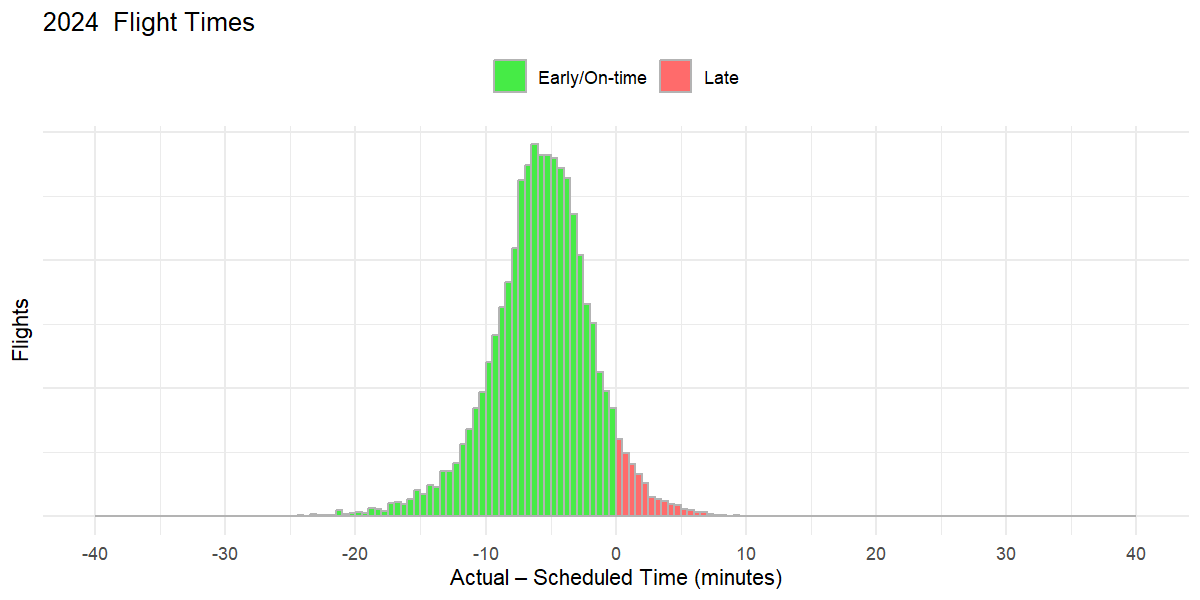
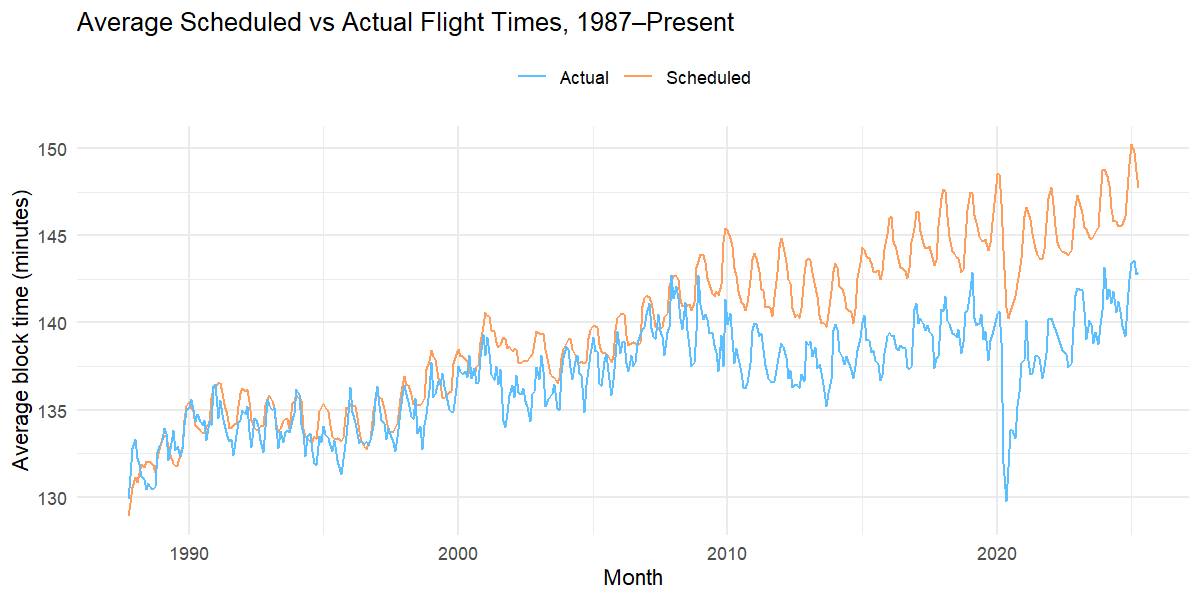

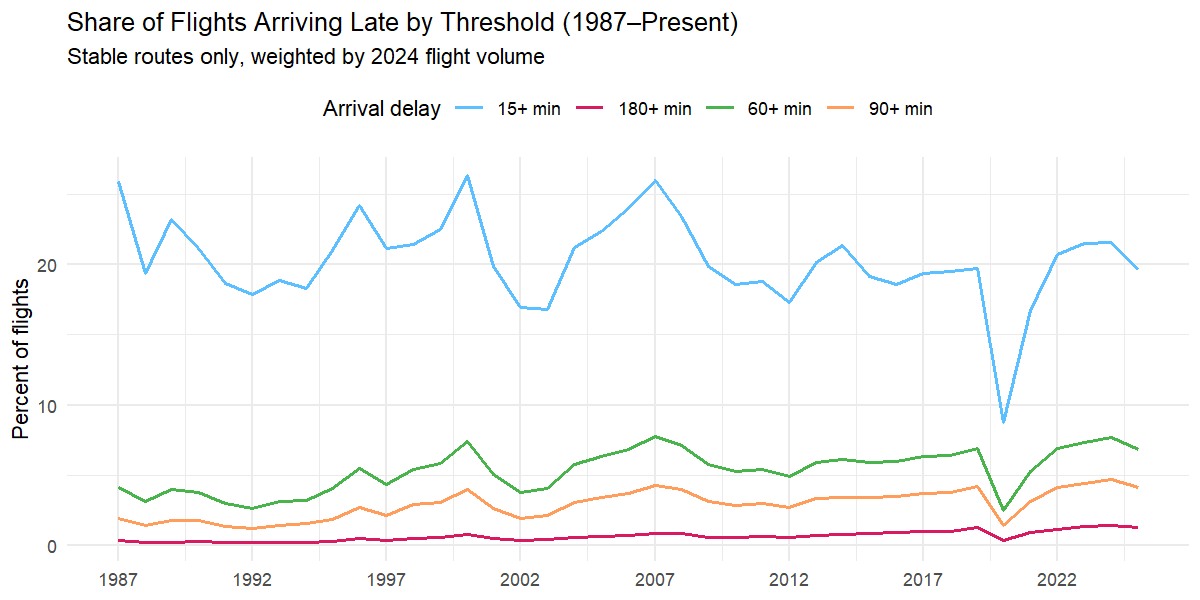
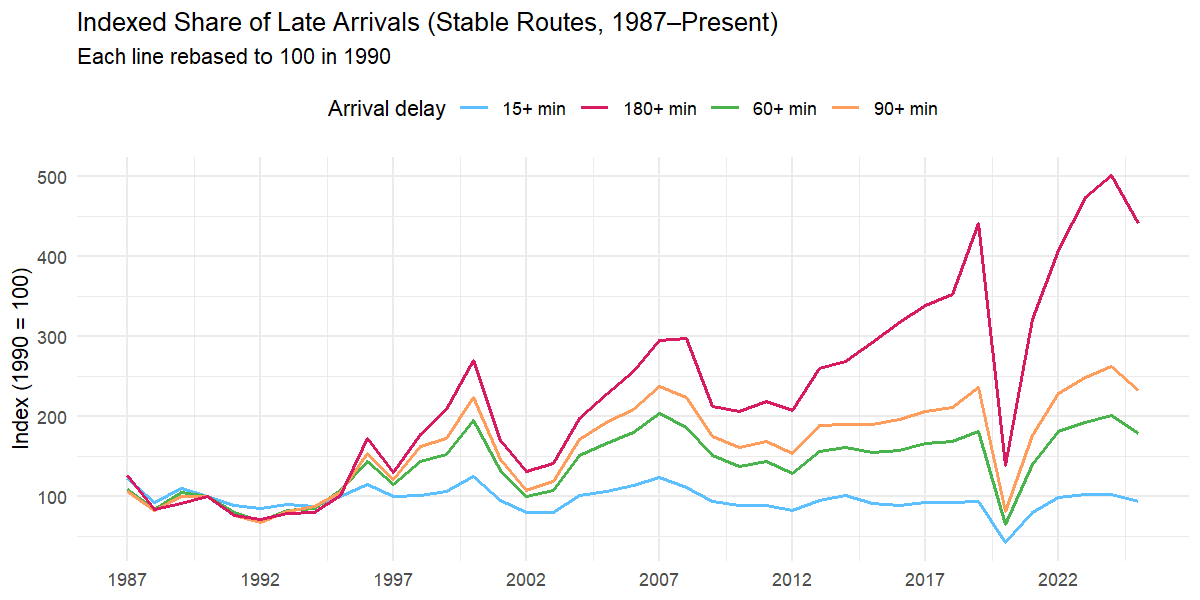
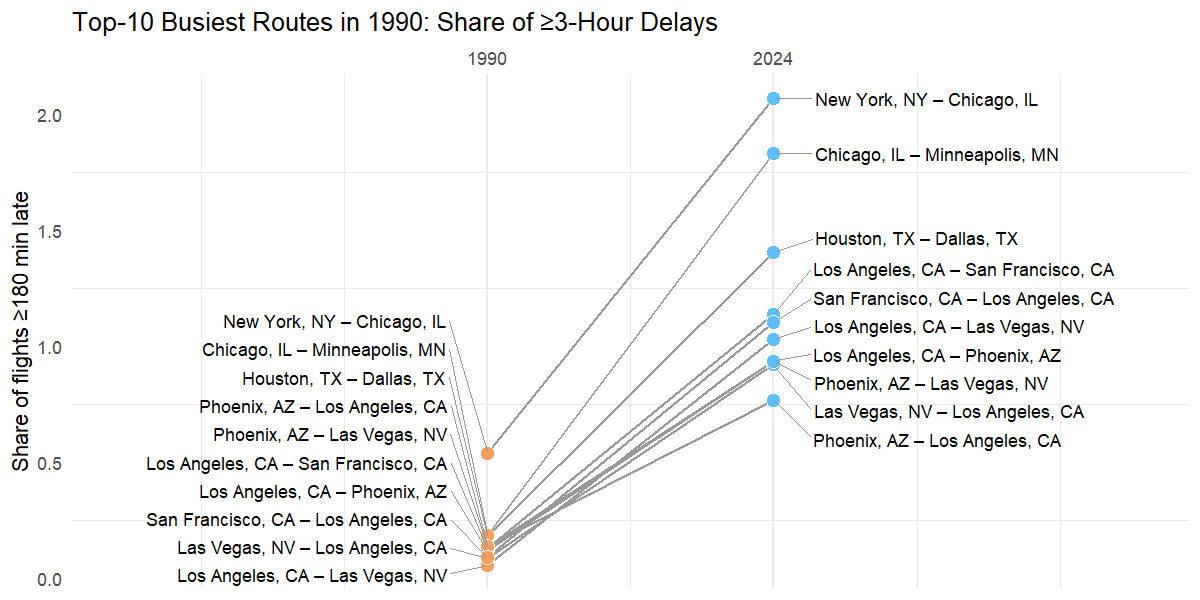

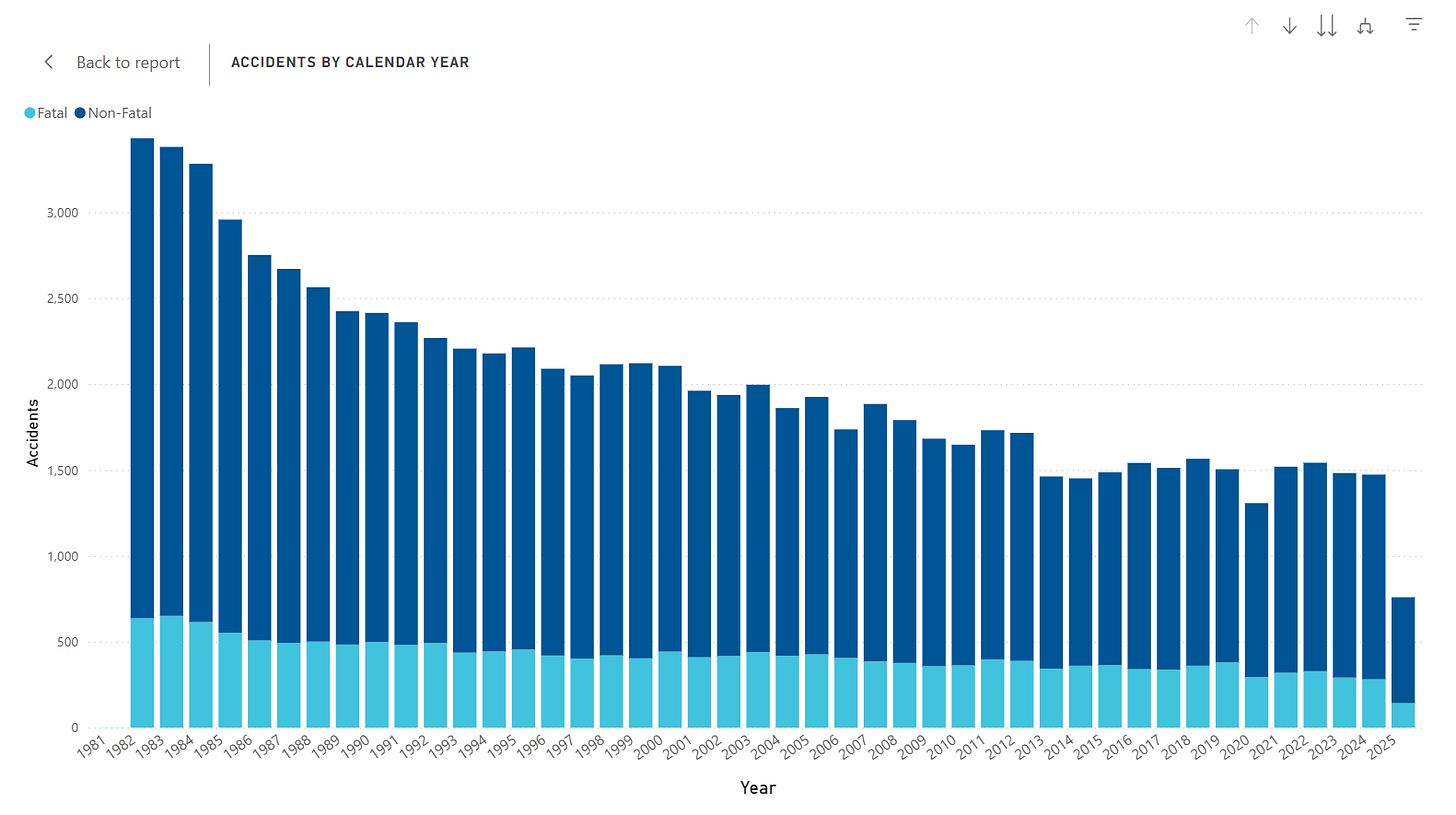
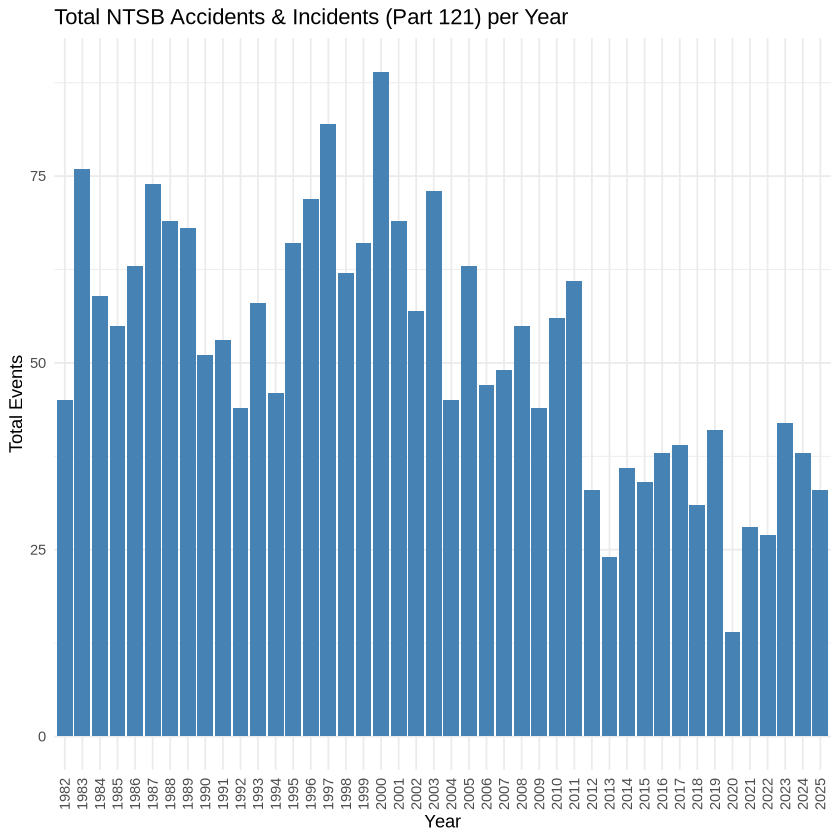
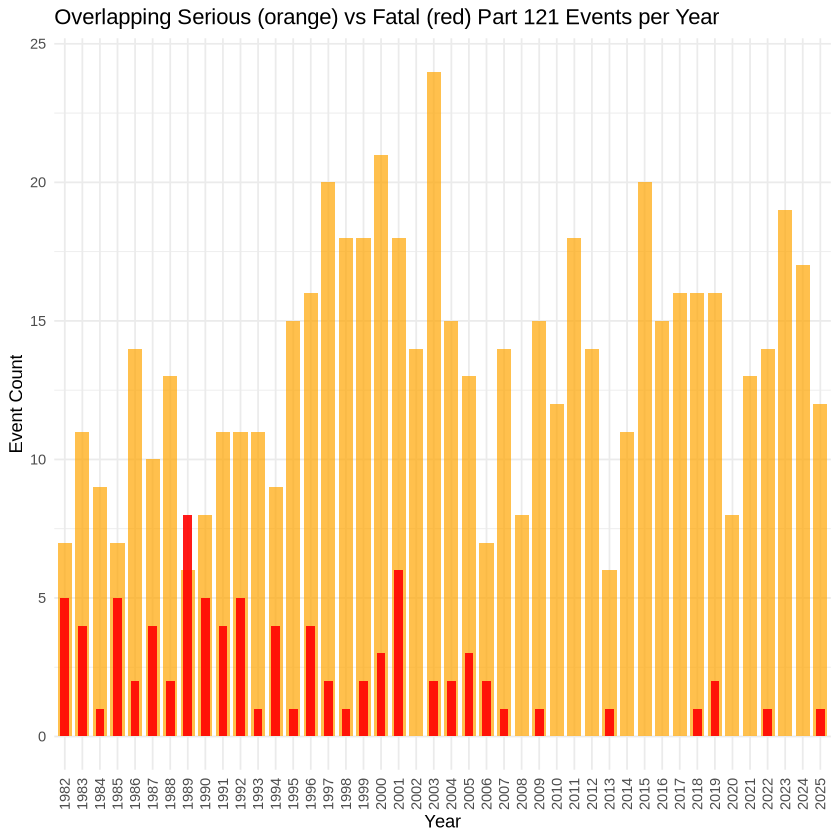
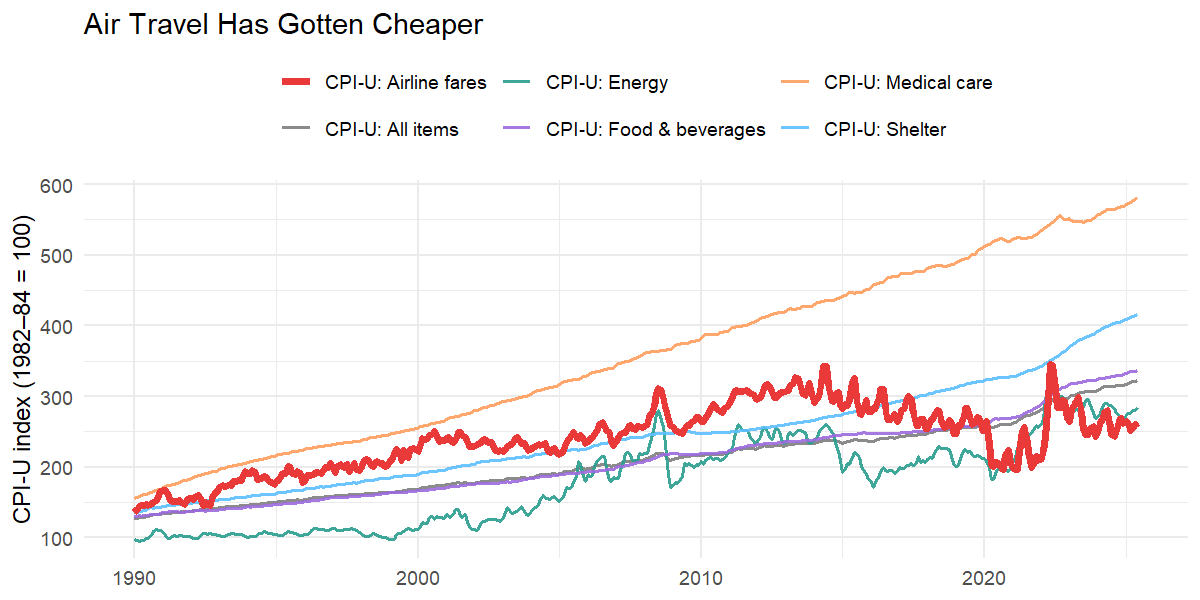
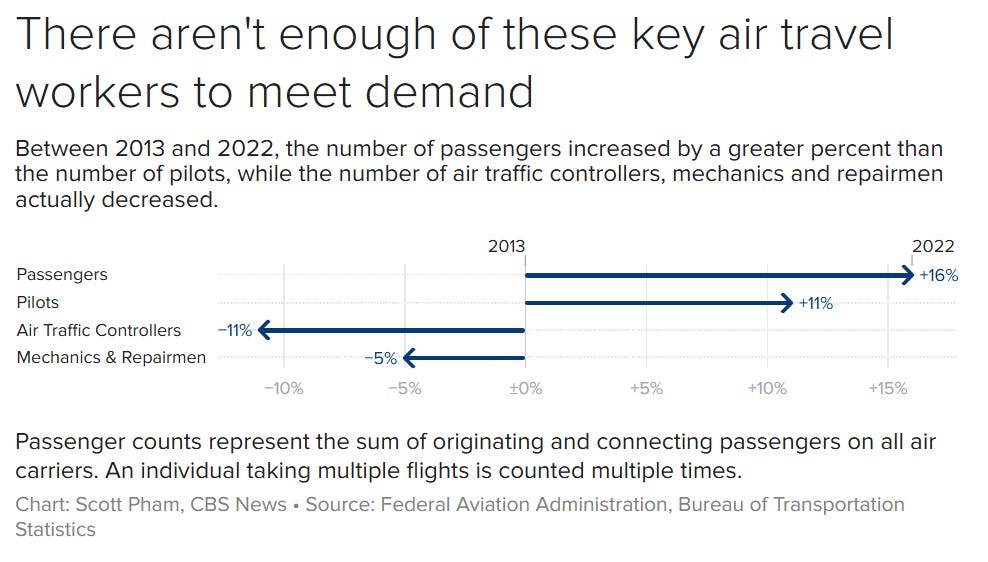
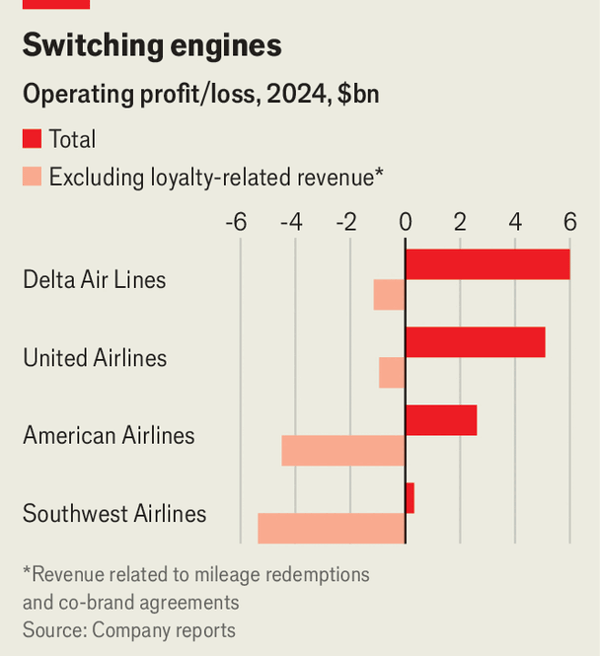
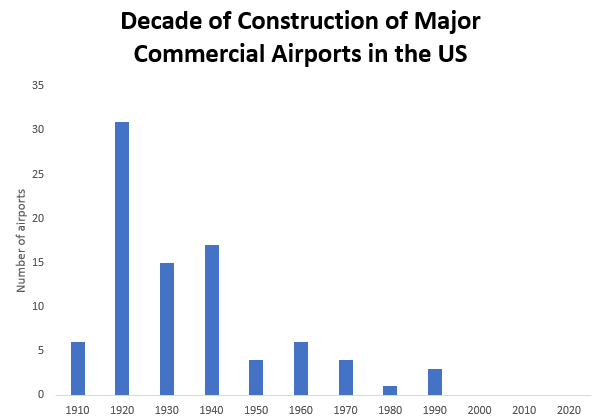
Worth noting that the sharp increase in schedule padding that emerges around 2009 is an artifact of regulatory changes. In 2009, the DOT finalized a rule against "unrealistic scheduling," as well as specifically forbidding "chronically delayed flights": https://www.ecfr.gov/current/title-14/chapter-II/subchapter-F/part-399
Since chronically delayed flights are defined as >30 min past scheduled arrival times, it caused airlines to start padding their schedules. "Unrealistic" scheduling isn't clearly defined, but that probably encourages even more conservatism in arrival estimates.
Nice piece! An alternative hypothesis:
- more flights are cancelled today when there is a question of aircraft reliability
- fewer flights are cancelled today when there would be a long delay*
That hypothesis could get you more very long delays, fewer safety accidents, and roughly constant cancellation rates. Maybe it also helps explain why we do not observe increases in minor delays after 1997 (if minor delays didn’t usually result in cancellation in the past), which I think we would expect from the congestion hypothesis.
*why would that be? Maybe to offset increased safety related cancellations? Maybe because airports are nicer and customers are more willing to wait in them? Not sure if that’s true. Or maybe it’s cheaper than booking everyone hotels? Or maybe it’s a consequence of greater logistical sophistication enabling airlines to avoid cascading problems from allowing flights to run very late?